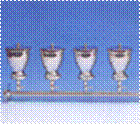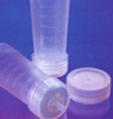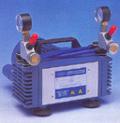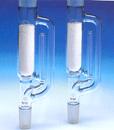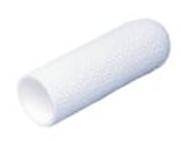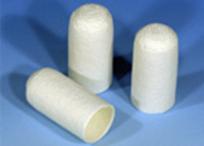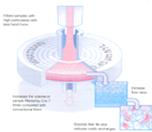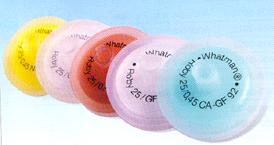
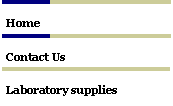
|
Laboratory Filters: |
|
1.1- Filter Paper: |
|
With different dimensions, speeds, grades and micron rating.
|
|
1.1-a: Ash (Qualitative): |
|
With different dimensions, speeds, grades and micron rating. |
|
1.1-b: Ashless (Quantitative): |
|
*MCE including cellulose nitrate and cellulose acetate, also known as nitrocellulose. It has high porosity, high protein, high purity, rapid wetting time and can be autoclaved withstands autoclaving temperatures up to 130°C.
*MCE used for many laboratory applications including filter sterilizing biological fluids, microbiology, contamination analysis and air monitoring.
|
|
1.2-a: Mixed Cellulose Ester "MCE": |
|
*CA is a mixture of cellulose triacetate and diacetate.
It has low static charge and high strength, CA could be sterilized without loss of integrity or change in bubble point.
*CA used to enhance the recovery of fastidious gram positive organisms, and it can be used as a filter for the enzyme solutions.
|
|
1.2-b: Cellulose Acetate "CA": |
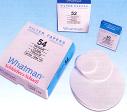
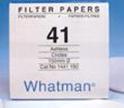
|
1.3- Disposable Syringe Filters "DSF": |
|
* Nylon membranes are very strong, heat resistant membranes and manufactured by impregnation a polyester web with the nylon polymer.
*Nylon membranes are inherently hydrophilic, and its compatible with aqueous, alcoholic solutions and solvents.
*Nylon membranes are suitable for HPLC samples preparations; it's used to clarify aqueous and organic solvents solutions including buffers, microbiological and tissue culture solutions. |
|
1.2-c: Nylon: |
|
There are two types of PTFE membranes: -Hydrophilic PTFE -Hydrophobic PTFE *Hydrophilic PTFE membranes are maximum chemical and PH resistance, it has high flow rates with minimal aqueous extractable. It is ideal for HPLC and other mixtures of aqueous extractable.
*Hydrophobic PTFE membranes are thin, highly porous, behaves as an absolute retentive membranes. It is supported with polypropylene laminated to one side to improve handling. Hydrophobic PTFE membranes are inert to most chemically aggressive solvents, strong acids and bases, and it can be used under high temperature up to 100°C.
*It is used in: · Sterilize gases: traps aqueous aerosols. · Air and gas venting: allows gases to pass freely while blocking. · aqueous liquids, protect vacuum pumps and critical samples. Sterilize and clarify strong acids and many other solvents incompatible with other membranes. |
|
1.2-d: PTFE: |
|
1.2-Membrane Filters:
Membrane filters are micro porous polymeric films with specific pore size rating. Membrane retain particles or microorganisms larger than their pore size primarily by surface capture. Some particles smaller than stated pore size may be returned by other mechanisms. Because there are more than one type of membranes, lets mention these types and their applications.
|
|
1.2-g: Glass Fiber Disk "GF": |
|
1-2-f: Regenerated Cellulose "RC": |
|
1.2-e : Cellulose Nitrate "CN": |
|
*GF discs are biologically and chemically inert, highly retentive depth filters with high dirt holding capacities.
*GF used for: · Gravimetric analysis of air particles. · Contamination analysis of waste water and industrial effluents. · Pre filtration of difficult to filter filtrations. · Cell harvesting and proteins or nucleic acid filtration techniques. |
|
*CN membranes manufactured from 100% pure cellulose nitrate. They are exceptionally hydrophilic.
*CN membranes are standard type with the widest separation range, which have proven themselves particularly well with the following applications:
· For particle measurement techniques, aerosol sampling, pre-filtration, separation of cells from viscous media, separation of yeast and fibers. · For microbiological studies, filtration of aqueous solutions, biochemical precipitation techniques and for molecular biology.
|
|
*RC membranes made of pure cellulose and has an outstanding chemical resistance to organic solvents and has high mechanical strength.
*RC membrane used for: · Purification of organic solvents, concentrated low alcohols. · Its excellent for HPLC samples preparation and buffer filtration
-Unfortunately it's expensive and Nylon can replace it.
|
|
Filtration accessories include: · SS or PP membrane filter Holder, for 13, 25 and 47 mm membranes. · Glass and SS Filtration Kit for 25 and 47mm membranes (complete or any part of it: flask, cup, support and clamp). · Vacuum pump. · SS or Glass Vacuum Manifold for biological use. SS filtration funnels.
|
|
1.4- Filtration Accessories : |
|
1-2-h: Polyvinylidene Fluride " PVDF" : |
|
*PVDF membranes is a naturally hydrophobic support matrix with binding capacities which are much more than that of CN membranes.
*Its chemically resistant to harsh reagents, non-flammable, very high binding capacities and higher mechanical strength than CN.
*PVDF used for protein staining, glycolipid detection, its ideal support for protein sequencing.
-Vivid can supply you with all these types as sterile, non-sterile, girded, non-girded and with all pore sizes and diameters.
|
|
Vivid provide a wide range of DSF, with different types of membranes suitable for any applications. DSF is constructed from the double layer housing and the membrane inside. The housing for the DSF is polypropylene which has a wide chemical compatibility and high heat resistance.
The choice of DSF is done according to the membranes inside it ( Nylon, PTFE,RC,CN…etc). Also it depends on the sample to be filtrated and the solvent. DSF are available in all pore sizes (0.2, 0.45mm….ets), dimensions (13, 25 and 47mm) and in sterile and non-sterile forms. |
|
1.5- Thimbles : |
